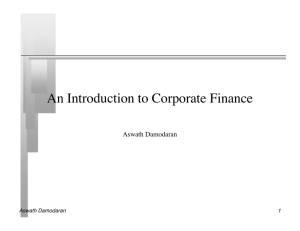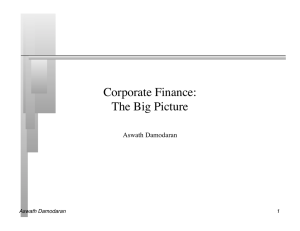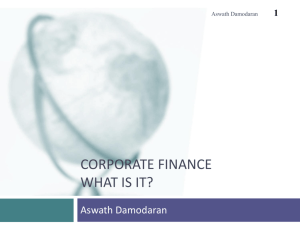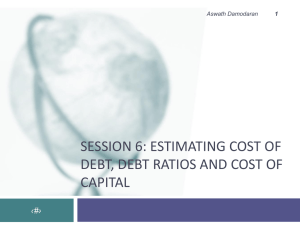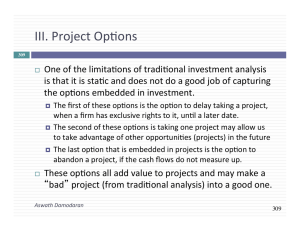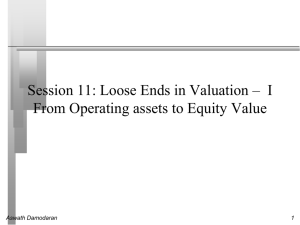SEC filings and annual reports: Separating the wheat
advertisement
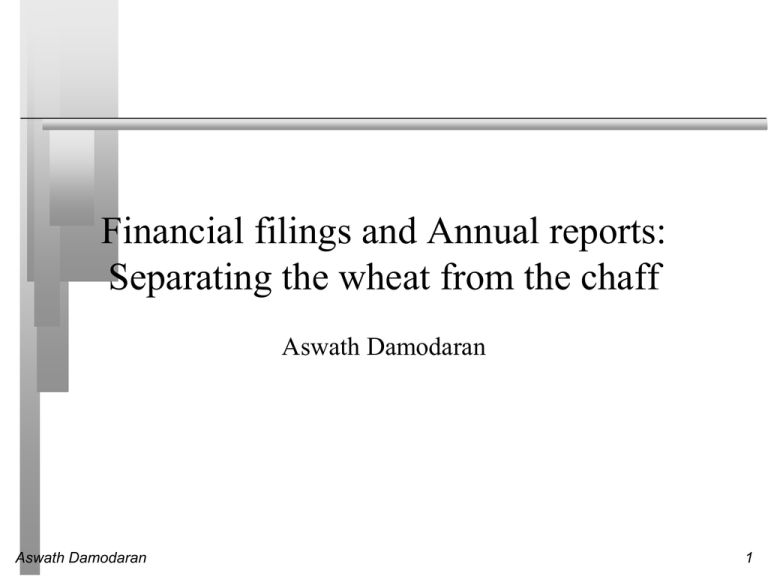
Financial filings and Annual reports: Separating the wheat from the chaff Aswath Damodaran Aswath Damodaran 1 Data versus Information In the interests of providing more information to investors, the SEC and the accounting standards boards (GAAP, IFRS) have required companies to reveal more and more about themselves. That is good news, but it is also bad news. Financial disclosures from firms have become “data dumps”, stretching to hundreds of pages and several GB of downloads. The key to using these financial disclosures in valuation and investing has become separating the “stuff that matters” from the ‘stuff that is noise” Aswath Damodaran 2 The key to making the distinction between information & noise 1. 2. Be focused: Reading financial statements cover to cover, looking for “interesting” and “important” stuff almost never works. Instead, start with focus, by defining the items that you want information on, at least in broad terms, and then classifying what you find along those categories. Tie the information to your valuation model/metrics: Broadly speaking, you can value a company in one of three ways: Intrinsic or DCF valuation, where the value of a company is estimated by forecasting out expected cash flows and discounting them. Relative valuation, where you are using a multiple and comparable firms, to make a judgment on value. Contingent claim valuation, where you value a business as an option. The information that you will get out of the financials will vary, depending on the approach you use. Aswath Damodaran 3 The drivers of value Determinants of Value Growth from new investments Growth created by making new investments; function of amount and quality of investments Current Cashflows These are the cash flows from existing investment,s, net of any reinvestment needed to sustain future growth. They can be computed before debt cashflo ws (to the firm) or after debt cashflows (to equity investors). Efficiency Growth Growth generated by using existing assets better Expected Growth during high growth period Terminal Value of firm (equity) Stable growth firm, with no or very limited excess returns Length of the high growth period Since value creating growth requires excess returns, this is a function of - Magnitude of competitive advantages - Sustainability of competitive advantages Cost of financing (debt or capital) to apply to discounting cashflows Determined by - Operating risk of the company - Default risk of the company - Mix of debt and equity used in financing Aswath Damodaran 4 The key valuation questions that you are trying to answer… Item Key questions Key inputs Cash flows from existing investments 1. How much capital is invested in existing assets? 2. How much did the firm earn on these assets? 1. Current revenues 2. Current earnings 3. Current capital invested (Debt + Equity – Cash) Future growth 1. How much growth from new investments? 2. How much growth from improved efficiency? 1. Revenue growth 2. Operating margin Quality of growth 1. How much new capital will the firm have to invest to deliver that growth? 1. Reinvestment 2. Return on invested capital Operating Risk 1. What businesses does the firm operate in? 2. What countries does the firm operate in? 1. Relative risk (Beta) 2. Equity Risk Premium 3. Cost of capital Financial Risk 1. How much debt does the firm have? 2. Are there any other contractual commitments? 1. Debt ratio 2. Cost of debt Other assets/ claims 1. Are there any non-operating assets? 2. Are there other claims on the equity? 1. Non-operating assets 2. Minority interests 3. Options outstanding Aswath Damodaran 5 A template for reading a “financial” disclosure Step Information Timing & Currency General: Period covered by the financials, Reporting currency Business mix General: Business segment breakdown (revenues), Geographic breakdown (revenues), Specific risks (not generic) Base year inputs for valuation Income statement: Revenues, Earnings, Interest exp, Tax rate Balance sheet: Book equity, debt outstanding, Cash & Working capital (WC), Cross holdings (minority & majority) Statement of cash flows: Change in WC, Capital Expenditures, Depreciation, Debt issued (repaid) Follow through Footnotes to financials: Operating lease, rental & other commitments, Employee options, Timing of debt due, Under funded obligations (pension & health care) Units Share count: Number of shares outstanding, Restricted stock units (RSUs), Acquisitions paid for with stock Corporate governance General: Differences in voting rights across share classes, special rights or privileges given to insiders etc. Aswath Damodaran 6 Valuing Procter & Gamble: September 2012 The timing issue in financial statements If you are valuing a company for a transaction (investment, acquisition etc.), you should use the most updated information that you can find on the company. While market numbers (interest rates, stock prices) get updated constantly, accounting numbers get updated at prespecified intervals (usually) once every quarter. To value P&G in September 2012, I started with the most recent 10K. That filing, which was made with the SEC in August 2012, reflects P&G’s financial year, which ends June 30, 2012. (See page 3 of the 10K). Since it is the most recent filing, it will be used in the valuation. If the year-end in the last 10K had been December 31, 2011, I would have obtained the last 10Q and calculated trailing 12 month numbers for flow numbers (income statement & statement of cash flows) and the balance sheet from the last 10Q for stock numbers (balance sheet). Aswath Damodaran 7 The pre-read: Browsing the 10K Aswath Damodaran 8 P&G: The key numbers… Aswath Damodaran 9 Some parting advice (suggestions)… Skip the pablum: Financial filings increasingly use legal boilerplate to protect companies against lawsuits. Thus, much of the risk discussion (P&G: 6-13) either states the obvious (“change in consumer demand”) or says nothing of value ( “successfully manage organizational change”) 2. Don’t sweat the small stuff: Significant sections of the financial filing will be dedicated to issues that are immaterial to your valuation or too “small” to make a difference. (See P&G Venezuela 34-35) 3. Cross check across financial statements: To make sure that you are not missing items or to catch inconsistencies, cross check your information. For instance, is the net capital expenditure in your statement of cash flows close to the change in fixed assets on the balance sheet? How about change in non-cash working capital? 4. Fill in the gaps: When you are missing information, make your best judgments based on either the company’s past financial statements, industry norms or common sense. Aswath Damodaran 1. 10


